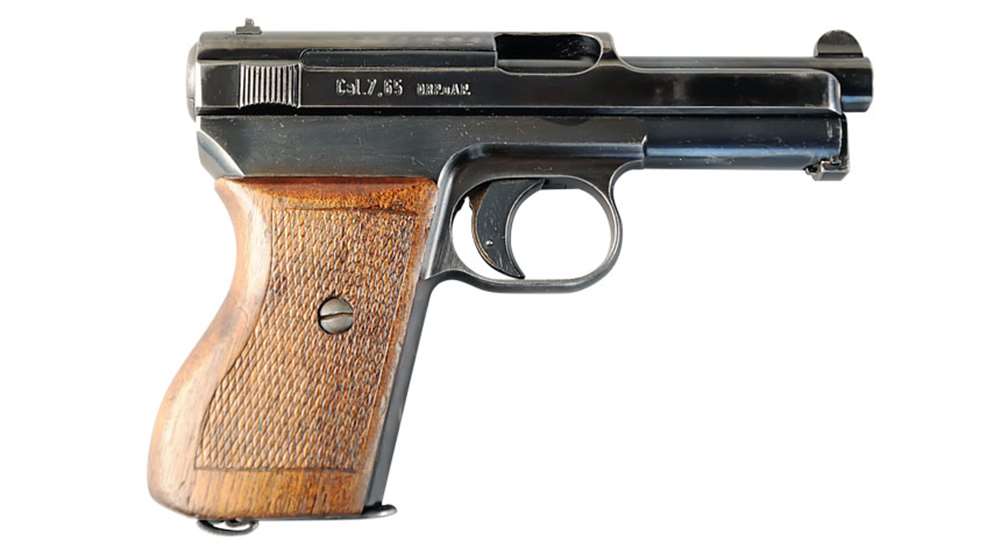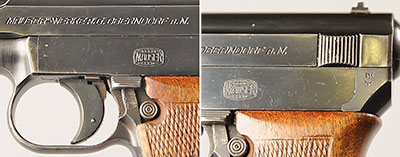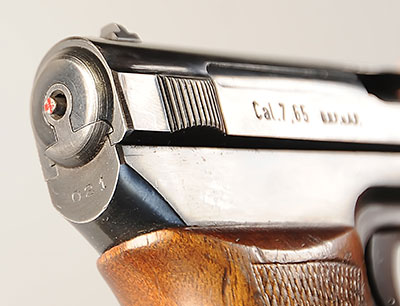
Like so many firearms, the 1934 Pocket Model pistol had something of a past. In the 1934’s case, it dates back to 1910 with Mauser’s introduction of a well-built, if somewhat oversize (for its chambering), 6.35 mm Browning (.25 ACP). In fact, this handy little pistol had a past of its own, as it was a follow-on to a not-so-successful Mauser 1909 blowback-operated 9 mm Luger. Like the 1909, the 1910 had a fixed barrel and was striker-fired. Some of the internals were also similar, but there were also many differences.
Beautifully made, the 1910 was certainly one of the more unusual-looking semi-automatics of the time, but it functioned well and became an instant hit with some 60,000 being built between 1910 and 1913. Production continued on the Model 1910 until 1934.
 The gun was so successful that Mauser decided to press its luck and, in 1914, introduced a larger 7.65 mm Browning (.32 ACP) version. Like its predecessor, the Model 1914 was a class act. Construction and design were superb. Stocks were normally checkered walnut; blue was the most common finish, but nickel was also seen, as were more exotic, engraved exteriors.
The gun was so successful that Mauser decided to press its luck and, in 1914, introduced a larger 7.65 mm Browning (.32 ACP) version. Like its predecessor, the Model 1914 was a class act. Construction and design were superb. Stocks were normally checkered walnut; blue was the most common finish, but nickel was also seen, as were more exotic, engraved exteriors.
The 1914 had some interesting features. The safety was extremely easy to use, consisting of a small lever sited just above the rear left side of the trigger guard. To put the gun on safe, the catch was pushed down. A button below the lever was pushed to release the safety—quick and handy. As well, the rear of the striker protruded through a hole in the rear of the slide when the gun was cocked. It was not, however, a loaded-chamber indicator. After all shots had been fired, the slide remained locked to the rear. When a loaded magazine was inserted, the slide automatically snapped forward, chambering a round.
The 1914 had a magazine-disconnect safety, and the magazine held eight rounds. It was secured in the pistol’s butt by means of a typical European-style heel catch. Over their life spans, the Models 1910 and 1914 went through several minor cosmetic and mechanical changes, but, for the most part, remained essentially the same. During World War I, the German military even purchased some 100,000 Model 1914s for its troops.
 With the rise of smaller, handier pocket pistols by other makers, Mauser decided to give the 1914 a minor facelift, so, in 1934, an “updated” version was marketed. In fact, mechanically the ’34 was virtually identical to the ’14, the most noticeable difference between the two being the introduction of a more comfortable, rounded grip on the newer pistol.
With the rise of smaller, handier pocket pistols by other makers, Mauser decided to give the 1914 a minor facelift, so, in 1934, an “updated” version was marketed. In fact, mechanically the ’34 was virtually identical to the ’14, the most noticeable difference between the two being the introduction of a more comfortable, rounded grip on the newer pistol.
Because it was considerably larger than many of its rivals, as good as it was, the 1934’s sales lagged and the company decided to cease production around 1941, favoring instead the more streamlined and compact double-action HSc.
Still, many thousands of 1934s were sold commercially, and quantities were purchased by the German police, Wehrmacht (army) and Kriegsmarine (navy). Normally guns with police or military markings/waffenamts will bring a premium—especially naval versions.
The excellent-condition pistol we’re looking at here is a late 1934, probably made toward the end of the pistol’s run. It does exhibit a waffenamt, and because of this is valued at $1,100. A civilian version in similar condition would bring about $450-$500 less, while a Kriegsmarine-marked specimen is worth an added $250.
Gun: 1934 Pocket Model
Manufacturer: Mauser-Werke
Chambering: 7.65 mm Browning (.32 ACP)
Condition: NRA Excellent (Antique Gun Standards)
Manufactured: c. 1939
Value: $1,100






















![Winchester Comm[94]](/media/1mleusmd/winchester-comm-94.jpg?anchor=center&mode=crop&width=770&height=430&rnd=134090756537800000&quality=60)
![Winchester Comm[94]](/media/1mleusmd/winchester-comm-94.jpg?anchor=center&mode=crop&width=150&height=150&rnd=134090756537800000&quality=60)











